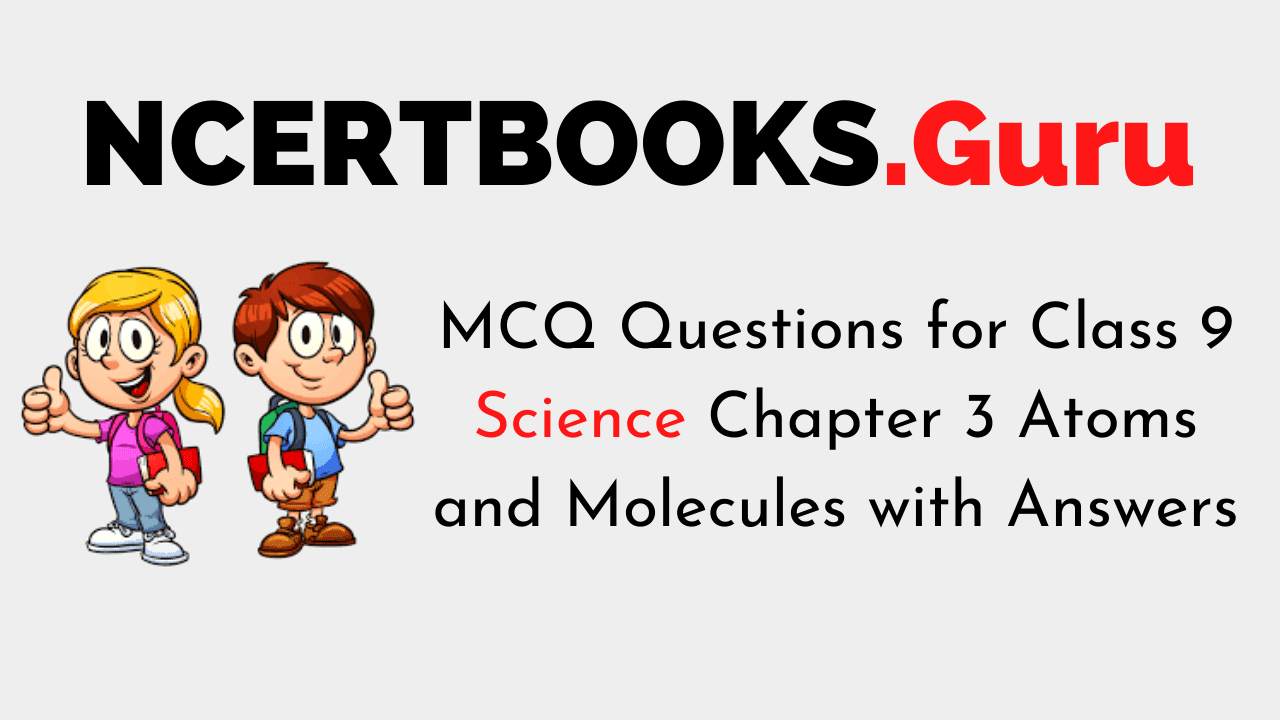MCQ Questions for Class 9 Science Chapter 3 Atoms and Molecules with Answers
MCQs from Class 9 Science Chapter 3 – Atoms and Molecules are provided here to help students prepare for their upcoming Science exam.
MCQs from CBSE Class 9 Science Chapter 3: Atoms and Molecules
1. Which of the following correctly represents 360g of water?
(i) 2 moles of water
(ii) 20 moles of water
(iii) 6.022 × 1023 molecules of water
(iv) 1.2044 × 1025 molecules of water
(a) (i)
(b) (i) and (iv)
(c) (ii) and (iii)
(d) (ii) and (iv)
Answer/ Explanation
(d) (ii) and (iv)
2. Which of the following statements is not true about an atom?
(a) Atoms are not able to exist independently.
(b) Atoms are the basic units from which molecules and ions are
formed.
(c) Atoms are always neutral in nature.
(d) Atoms aggregate in large numbers to form the matter that we can see, feel or touch.
Answer/ Explanation
(d) Atoms aggregate in large numbers to form the matter that we can see, feel or touch.
3. 1 u or 1 amu means
(a) 1/12th mass of C-12 atoms
(b) Mass of C-12 atom
(c) Mass of O-16 atom
(d) Mass of Hydrogen molecule
Answer/ Explanation
(a) 1/12th mass of C-12 atoms
4. Which of the following contains maximum number of molecules?
(a) 19 CO2
(b) 1 g N2
(c) 1 g H2
(d) 1 g CH4
Answer/ Explanation
(c) 1 g H2
5. A sample of NH3 molecule irrespective of source contains 82.35% Nitrogen and 17.65% of Hydrogen by mass. This data supports:
(a) Law of Conservation of Mass
(b) Las of Multiple Proportions
(c) Law of Definite Proportions
(d) Avogadro’s Law
Answer/ Explanation
(c) Law of Definite Proportions
6. An element X is divalent and another element Y is tetravalent. The compound formed by these two elements will be:
(a) XY
(b) XY2
(c) X2Y
(d) XY4
Answer/ Explanation
(b) XY2
7. The molecular formula of potassium nitrate is ________.
(a) KNO3
(b) KNO
(c) KNO2
(d) KON
Answer/ Explanation
(a) KNO3
8. 3.42 g of sucrose are dissolved in 18 g of water in a beaker. The numbers of oxygen atoms in the solution are:
(a) 6.68 ×1023
(b) 6.09 ×1022
(c) 6.022 ×1023
(d) 6.022 ×1021
Answer/ Explanation
(a) 6.68 × 1023
9. Molecular mass is defined as the:
(a) Mass of one molecule of any substance compared with the mass of one atom of C – 12
(b) Mass of one atom compared with the mass of one atom of hydrogen
(c) Mass of one atom compared with the mass of one molecule
(d) None of the above
Answer/ Explanation
(a) Mass of one molecule of any substance compared with the mass of one atom of C – 12
10. A change in the physical state can be brought about
(a) only when energy is given to the system
(b) only when energy is taken out from the system
(c) When energy is either given to, or taken out from the system
(d) Without any energy change
Answer/ Explanation
(c) When energy is either given to, or taken out from the system
11. The atomic mass of sodium is 23. The number of moles in 46g of sodium is ________.
(a) 4
(b) 2
(c) 0
(d) ½
Answer/ Explanation
(b) 2
12. Which of the following represents a correct chemical formula?
(a) CaCl
(b) BiPO4
(c) NaSO4
(d) NaS
Answer/ Explanation
(b) BiPO4
13. What is the formula mass unit of ZnO?
(a) 18 u
(b) 81 u
(c) 88 u
(d) 188 u
Answer/ Explanation
(b) 81 u
14. How many atoms of oxygen are present in 300 grams of CaCO3?
(a) 54.207 × 1023
(b) 6.207 × 1023
(c) 12.207 × 1023
(d) 22.2 × 1023
Answer/ Explanation
(a) 54.207 × 1023
15. Which of the following represents the correct relation between Avogadro’s number (No), number of particles (N) and moles (n)?
(a) n = N / No
(b) n = No / N
(c) n = N No
(d) all are correct
Answer/ Explanation
(a) n = N / No
